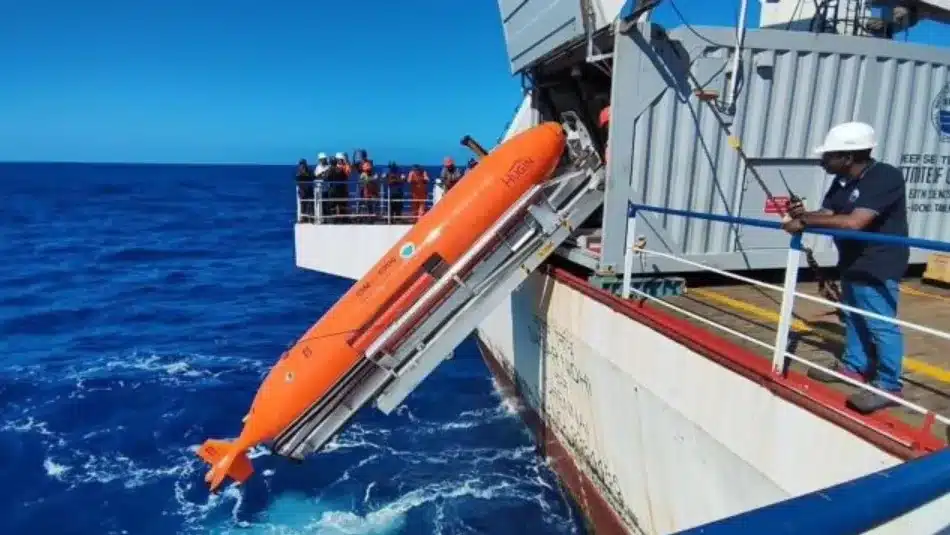What’s in today’s article?
- Why in News?
- What is Deep Ocean Mission (DOM)?
- What Are Hydrothermal Vents?
- Imaging of underwater hot spring
Why in News?
Indian oceanographers have achieved a historic feat by capturing an image of an active hydrothermal vent located 4,500 meters below the Indian Ocean.
This discovery, made under the Ministry of Earth Sciences’ Rs 4,000-crore Deep Ocean Mission, holds immense potential for mineral exploration.
What is Deep Ocean Mission (DOM)?
- About
- DOM is a program to explore the deep ocean and develop technologies to use its resource.
- The mission, estimated at Rs. 4,077 crore over five years, will be implemented in phases.
- The first phase (2021-2024) has an allocation of Rs. 2,823.4 crore.
- This mission-mode project supports India’s Blue Economy initiatives, with MoES serving as the nodal ministry to coordinate this multi-institutional effort.
- Goal
- To develop technologies to use the ocean’s living and non-living resources, and to improve understanding of the ocean’s role in climate change
- Components
- The mission has six main components, including:
- Manned submersible: A submersible to carry three people to depths of 6,000 meters, equipped with scientific tools and sensors
- Ocean climate change advisory services: To develop models and observations to understand and predict climate variables
- Deep-sea biodiversity: To study the flora and fauna of the deep sea, including microbes, and to develop ways to use the ocean’s bio-resources sustainably
- Deep ocean survey and exploration: To identify potential sites for multi-metal hydrothermal sulfide mineralization in the Indian Ocean
- Energy and freshwater: To develop ways to use the ocean for energy and freshwater
- Advanced marine station: To establish a station for ocean biology
- The mission has six main components, including:
- Lead agencies
- The Ministry of Earth Sciences (MoES), the Department of Biotechnology (DBT), the Department of Space (DoS/ISRO), the Ministry of New and Renewable Energy (MNRE), and other organizations.
What Are Hydrothermal Vents?
- Hydrothermal vents are underwater springs found near tectonic plate boundaries.
- They occur when cold water at the seabed (around 2°C) interacts with magma in tectonically active regions, heating up to 370°C.
- This superhot water emerges as plumes, rich in minerals and gases, through vent chimneys and fissures.
Imaging of underwater hot spring
- The Discovery Process
- Survey History
- The National Centre for Polar and Ocean Research (NCPOR) in Goa has been conducting geophysical surveys in the Central and Southern Indian Ocean Ridges since 2012 to locate hydrothermal vents.
- Recent Campaign
- In April 2024, NCPOR and the National Institute of Ocean Technology (NIOT) conducted high-resolution imaging along the Central Indian Ridge, narrowing their search using an automatic underwater vehicle (AUV).
- Historic Image captured
- The Indian AUV launched from the research vessel Sagar Nidhi captured a high-resolution image of the vent during a 12-15 hour observation campaign.
- Survey History
- Significance
- Mineral-Rich Deposits
- Hydrothermal vents are significant due to their deposits of valuable minerals and metals.
- These are: Copper, Zinc, Gold, Silver, Platinum, Iron, Cobalt, Nickel etc.
- These deposits can remain active for hundreds to thousands of years, making them economically and scientifically vital.
- Biological Insights
- Hydrothermal vents support unique ecosystems.
- Chemosynthetic organisms thrive by utilizing chemicals enriched with minerals and metals, similar to how plants use sunlight for photosynthesis.
- Chemosynthetic organisms are organisms that use chemical reactions to create food, rather than sunlight, and include bacteria and archaea.
- Significance for India’s Deep Ocean Mission
- This discovery boosts India’s Deep Ocean Mission, especially the Samudrayaan initiative, focusing on mineral exploration.
- The findings confirm earlier surveys and open new opportunities for understanding deep-sea ecosystems and resource potential.
- India as a leading player in deep-sea exploration
- This milestone positions India as a leading player in deep-sea exploration, with promising implications for scientific and economic advancements.
- Future Exploration Plans
- NCPOR plans to intensify exploration through TV-guided grab sampling to study the economic and biological potential of these vents further.
Q.1. What is the significance of hydrothermal vent imaging for India’s Deep Ocean Mission?
Capturing images of hydrothermal vents boosts India’s Deep Ocean Mission by identifying mineral-rich deposits and unique microbial ecosystems. It aids in understanding the deep-sea environment and advancing India’s Blue Economy initiatives.
Q.2. What resources are found in hydrothermal vent deposits?
Hydrothermal vents are rich in valuable minerals and metals, including copper, zinc, gold, silver, platinum, iron, cobalt, and nickel. These deposits hold economic and scientific significance for exploration and sustainable resource use.
News: Why imaging of underwater hot spring active with microbial life is significant for India’s Deep Ocean Mission | Ministry of Earth Sciences
Last updated on June, 2025
→ UPSC Notification 2025 was released on 22nd January 2025.
→ UPSC Prelims Result 2025 is out now for the CSE held on 25 May 2025.
→ UPSC Prelims Question Paper 2025 and Unofficial Prelims Answer Key 2025 are available now.
→ UPSC Calendar 2026 is released on 15th May, 2025.
→ The UPSC Vacancy 2025 were released 1129, out of which 979 were for UPSC CSE and remaining 150 are for UPSC IFoS.
→ UPSC Mains 2025 will be conducted on 22nd August 2025.
→ UPSC Prelims 2026 will be conducted on 24th May, 2026 & UPSC Mains 2026 will be conducted on 21st August 2026.
→ The UPSC Selection Process is of 3 stages-Prelims, Mains and Interview.
→ UPSC Result 2024 is released with latest UPSC Marksheet 2024. Check Now!
→ UPSC Toppers List 2024 is released now. Shakti Dubey is UPSC AIR 1 2024 Topper.
→ Also check Best IAS Coaching in Delhi






















